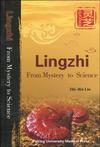灵芝从神奇到科学
出版时间:2009-6 出版社:北京大学医学出版社 作者:林志彬 页数:162
前言
Lingzhi (Ganoderma lucidum) is historically a treasured herbalmaterial in China. It is becoming well-known all over the world inrecent years. The Chinese traditional medicine's classic, ShetmongMateria Medica regards Lingzhi as being of a "supremely exquisite"quality with tonic and longevity effects. Over the years, fables andlegends adored Lingzhi with a patina of mystery as a "heavenly herb"that connotes auspiciousness, blissfulness and happiness.Professor Zhi-Bin Lin, a distinguished pharmacologist, hasdevoted a life-long study on Lingzhi. With his extraordinary insightson the culture, pharmacology, physiology, chemistry and clinicalapplications associated with Lingzhi, Prof. Lin presents in this bookthe scientific understanding of the herb's beneficial functions onhuman immune, nervous, endocrine and cardiovascular systems.Thus, Lingzhi has been applied as an adjuvant treatment for cancerpatients, and also a food supplement to improve general health andwellness.Lingzhi from Mystery to Science is written based on actualresearch and clinical findings. Prof. Lin explains the complextheories in commonly understandable language.
内容概要
Lingzhi (Ganoderma lucidum) is historically a treasured herbalmaterial in China. It is becoming well-known all over the world inrecent years. The Chinese traditional medicines classic, ShetmongMateria Medica regards Lingzhi as being of a "supremely exquisite"quality with tonic and longevity effects. Over the years, fables andlegends adored Lingzhi with a patina of mystery as a "heavenly herb"that connotes auspiciousness, blissfulness and happiness.ingzhi (Ganoderma lucidum) is historically a treasured herbalmaterial in China.
书籍目录
Chapter1 Mystery and Culture of Lingzhi Lingzhi in myths Lingzhi in ancient poems "Catholicon" according to Taoism Auspicious symbol for Chinese Guo Mo-Ruo's poem on LingzhiChapter2 Lingzhi as Described in Shennong Materia Medica Shennong Materia Medica on Lingzhi Scientific understanding on Lingzhi by scholars in early years Criticism on misinformation regarding Lingzhi in the old time Current understanding of the six kinds of Lingzhi Interpretation of Shennong Materia Medica using the traditional Chinese and Western medicine principles Chapter3 Understanding Lmgzhi Lingzhi fruiting body-a Chinese medicine Life cycle of Lingzhi Morphological characteristics ofhyphae, fruiting body and spores Cultivation of Lingzhi for its fruiting bodies Submerged fermentation for Lingzhi mycelia Lingzhi's "genealogy" revealed by DNA fingerprinting Organic cultivation of Lingzhi Lingzhi's active components and pharmacological effectsChapter4 Prevention and Treatment of Chronic Bronchitis with Lingzhi Chronic bronchitis Therapeutic efficacy of Lingzhi on chronic bronchitis Immunorcgulating nature of Lingzhi Chapter5 Prevention and Treatment of Hyperlipidemia with LingzhiChapter6 Anti-Hypertensive Effects of LingzhiChapter7 Preventive and Therapeutic Effect of Lingzhi on Diabetes MellitusChapter8 Prevention and Treatment with Lingzhi for NeurasthenisChapter9 Prevention and Treatment of Hepatitis with LingzhiChapter10 Adjuvant Therapy for Cancers with LingzhiChapter11 Care for Health of the Sub-Healthy Middle-Aged and ElderlyChapter12 Lingzhi Minimizes Poisoning Effect of Poisonous MushroomsChapter13 Lingzhi for Treatment of Other DiseasesChapter14 Recommendations in Choosing and Using Lingzhi ProductsChapter15 Processing Technology for Lingzhi ProductsAppendix
章节摘录
插图:In the Flying Dragon, he told a story of hisencounter in the misty Mt. Tai with a Taoist monk on a white deerwith a Lingzhi in his hand. It was from that man he learned the magichealth benefits of Lingzhi.In the Singing Trip era Han Dynasty Yuefu-style poem, a similarstory was told. The author met a god-like man with short hair andlong ears riding a white deer, and was led to pick Lingzhi. At thelegendary man's home, he was shown the tonic made from thehealth-improving, hair-color darkening, and life-prolonging effects ofthe reddish herb.The "Lingzhi culture" was greatly influenced by Taoism, thenative religion in China. Taoism believes that living is most impor-tant and that human beings can be immortal by following the regimensand taking a certain magical herbs. Bao Pu Zi written by Ge Hongpresented the theory suggesting that a person could learn to becomeimmortal. It even included stories of such occurrences by takingLingzhi.The ancient Taoist theory considered Lingzhi as the best amongthe catholicons, and by consuming Langzhi, one would never growold or die. Therefore, Lingzhi acquired the names, such as Shenzhi(heavenly herb) and Xiancao (magic grass), and became mystified. Inthe book of Ten Continents in the World, Lingzhi grew everywherein the fairy land. Gods fed n it to gain immortality. In the JinDynasty, Wang Jia's Picking Up the Lost and in the Tan Dynasty, DaiFu's The Vast Oddities, 12,000 varieties of Lingzhi were said to becultivated on acres of land in Mt.
编辑推荐
《灵芝从神奇到科学》是由北京大学医学出版社出版的。
图书封面
评论、评分、阅读与下载
用户评论 (总计5条)
- 神奇的灵芝,科学地认识。要想正确认识了解灵芝使用灵芝,该本书籍最新论点,加上作者本身的研究,可以通俗言简意赅的获得答案! 不愧为一本好书!
- 林志彬是我国研究灵芝的真正专家,用西医的方法研究中医的药材,科学客观,收获颇多,是认识灵芝的权威图书!林教授的这种研究方法应该是探索中药材的药性的唯一方法,而不能靠忽悠,才是发展中医的方法啊!!
- 详细介绍了灵芝的功效
- 这本书非常的不错,我很喜欢,帮朋友买了三回了每次20本!
- 还好,堆灵芝有了一些更进一步 的了解
相关图书
- 新编预算会计
- 2008高等财经教育研究
- 国际经济学
- 农村合作金融机构纳税筹划
- 政府预算实务与案例
- 中国《资本论》年刊(第六卷)
- 中国生态财政制度与政策研究
- 管理者自利条件下的公司盈利能力与资本结构研究
- 资源环境约束下的钢铁产业整合研究
- 高校学生工作创新与思考
- 特别纳税调整实务指南
- 新《增值税暂行条例》解读及会计处理
- 2009年最新国家税收法规与税收策解读
- 会计准则与会计制度应用指南
- 价值链会计
- 电子支付与安全
- 中国农村土地权利制度专题研究
- 信贷风险管理
- 国民经济统计学
- 管理心理学
- 线性代数简明教程
- 统计学概论
- 企业会计政策选择若干问题研究
- 英语
- 深入学习实践科学发展观进一步开创工商行政管理改革发展的新局面
